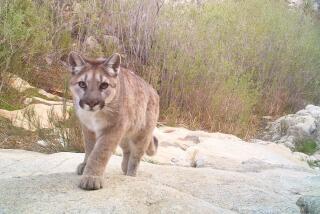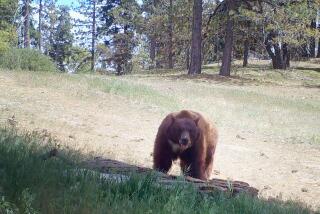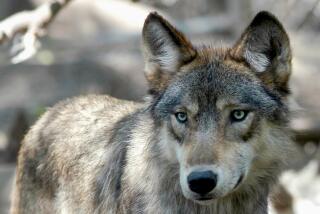Hunting humans?
In 1991, a young bicycle racer disappeared while on a training run behind his high school in the Rocky Mountain foothills near Denver.
Three years earlier, wildlife biologist Michael Sanders had attended a national conference in Prescott, Ariz., seeking advice on some small mysteries. Only in retrospect did he realize how clearly the clues he gathered at that event had portended the young athlete’s disappearance.
For six months before the conference, Sanders had been working with tracker and biologist Jim Halfpenny, studying cougars on the outskirts of the environmentally progressive town of Boulder, Colo. He was hardly a cougar expert yet, but Sanders did know enough to realize that Boulder’s lions were not behaving in the manner that they should. The scientific literature suggested that cougars were elusive, timid, frightened of humans and their dwellings, yet Boulder’s cougars wandered through backyards in broad daylight and jumped onto roofs, seemingly unfazed by the presence of people.
He and Halfpenny feared for public safety. Should they?
The new frontier
Boulder in the late ‘80s offered a glimpse of what our nation is becoming: a country where people build new homes on undeveloped land, pay to preserve the open space beside it, attract deer and other animals into their yards, and — by embracing wilderness and wildlife — alter the very nature of what they presume nature to be.
These countervailing forces — humans moving out and wildlife moving in, lands being developed and neighboring lands being restored — present both an unprecedented paradox and a surprising phenomenon: the return of the American frontier, which historian Frederick Jackson Turner defined as “the meeting point between savagery and civilization,” more than a century after it was officially declared closed. Here, on the convoluted boundaries between the wild and suburbia, people coexist with creatures their pioneer forebears tried their best to exterminate.
Mountain lions, Sanders learned, have become so numerous across the American West that some biologists believe the cats may be as abundant today as when Lewis and Clark paddled through the region two centuries ago. In December 1988, he arrived at the mountain lion workshop in Prescott armed with written reports of recent lion sightings and photos.
“Here are some pictures of what we’ve seen in Boulder,” he told attendees, cornering them in hallways or over dinner or while drinking Budweiser and shooting pool at a bar on Whiskey Row, Prescott’s famous saloon-lined street. “What do you think? How would you deal with it?”
Conference organizer Harley Shaw, a well-known Arizona cougar researcher with vast experience and a thoughtful, gentle manner, spoke at length with Sanders. “I didn’t think mountain lions would live near people,” Shaw recalls. “Most of us were a little surprised that this was happening.” Still, Shaw saw no reason for concern in Sanders’ reports. “I thought it was probably temporary, quirky .none of us really felt that this was going to be a major issue.”
Actually, one man at the conference did think that Sanders’ observations suggested a major, frightening trend. He had come to the meeting from California, a state that had recently suffered two high-profile cougar attacks. Both had occurred in Orange County, on the edge of suburbia.
The first attack had come almost three years earlier, in March 1986. Susan and Donald Small had taken their children, 9-year-old David and 5-year-old Laura, for a hike at Ronald W. Caspers Wilderness Park, a 7,600-acre county-owned preserve frequented by backpackers, equestrians and picnickers in the foothills of the Santa Ana Mountains. The family drove past the visitor center (where an interpretive display featured a photo of a cougar kitten with the caption “The Cougar or ‘Mountain Lion’ is quiet and secretive, with a healthy aversion to humans”), parked in a gravel lot, headed up the nature trail, and paused beside a shallow stream. Young Laura — blond and blue-eyed, wearing shorts and a sleeveless top — had removed her sandals and waded into the water to catch tadpoles when her mother glimpsed a muscular animal leaping from the brush. It grabbed Laura by the head and vanished with her in its mouth.
As Laura’s mother, Susan, recounted later: “I was just standing next to her, then the next second there was total silence. I didn’t hear any growling, Laura didn’t scream, I didn’t hear any dragging. They were gone. And I could see that they had gone behind me, but when I turned around there was no sign at all of them. There were no marks on the ground. There was nothing. I could hear the stream, that was all I could hear . [A]nd that was when I heard Laura . It sounded like moaning.” While her son, David, ran for help, Susan and her husband searched the cacti and underbrush, eventually locating their child, still locked in the jaws of the large cat, squirming and covered with blood. Laura was badly injured: her scalp and nose and upper lip hung loose, her right eye had been sliced open , her skull was crushed, and a portion of the brain beneath had been effectively liquefied by the trauma.
Laura was still alive, however. A stick-wielding stranger, whose heroism would later earn him a medal and $2,500, persuaded the lion to drop the girl. Laura’s parents, taking turns carrying her, rushed their daughter down the trail. A helicopter airlifted her to Mission Community Hospital and, in a 13-hour emergency operation, doctors saved Laura’s life. (Her initial hospitalization lasted 38 days, followed by years of reconstructive surgery and physical therapy. She remains blind in one eye and partially paralyzed.)
The morning after Laura’s attack, a government hunter killed the lion believed responsible, about half a mile from where the incident had occurred. The male cougar “appeared very emaciated and sick,” according to an official incident report.
Initially, it seemed that the cougar attack — California’s first since a mauling by a rabid lion in 1909 — was the sudden, unexpected and desperate act of a sick animal. But that explanation didn’t hold. A postmortem exam of the cat found no signs of serious illness, and park officials soon revealed that months of unusual lion behavior had foreshadowed the Smalls’ ordeal. The preceding September, a mountain lion had reportedly stalked a family of four hiking in Caspers Park; the father threw rocks to drive the animal away.
Then, seven months after Laura Small’s attack and after the offending lion had been killed, a cougar struck again — also on the nature trail, also on a Sunday, also on a family hike. This time the victim was 6-year-old Justin Mellon, snatched by the cat as he ran to catch up with others after tying his shoe.
Mellon’s injuries were far less severe than Laura’s. He had suffered multiple cuts, but the lion had not crushed his skull. Despite a massive search, hunters with dogs failed to locate the cougar that had mauled him.
The attacks fueled a smoldering political fight. In 1971, the California legislature had imposed what was supposed to have been a temporary moratorium on mountain lion hunting, intended to give biologists time to evaluate the health of the state’s cougar population. The hunting ban was supposed to last four years, but lawmakers and the courts have continued to extend it.
In 1985, before the maulings in Orange County, UC Davis wildlife biologist Lee Fitzhugh had written to Gov. George Deukmejian urging that the hunting moratorium be lifted: “In the past month at least three incidents of close contact between unsuspecting humans and mountain lions occurred in California, in residential areas. Mountain lion attacks on humans, especially children, are well documented.”
At the time he wrote the letter, Fitzhugh looked like a fear monger. After Laura Small’s ordeal, his warnings appeared prophetic. As Fitzhugh spoke at the Prescott conference, his words seemed directed toward Boulder. Fitzhugh made a bold and controversial argument — that, under certain as yet ill-defined circumstances, healthy cougars can learn to view humans as prey. “I knew there was a body of biologists that were still saying, ‘This can’t happen,’ ” he recalled later, “and I wanted to disabuse them of that thought.”
Fitzhugh spoke of the attacks in Orange County and of the close encounters that had preceded them, and he described what witnesses had seen: The cougars had crouched and swept their tails while eyeing humans. “These traits indicate predatory, rather than defensive, behavior,” Fitzhugh said. In other words, the bold actions of the cougars in Caspers Park could not be explained as the simple result of curiosity or fear or territoriality; the lions were sizing up park visitors as potential meals.
“Prey recognition is a learned behavior in cats,” he told the audience, and he cited the experience of wildlife rehabilitators in California who successfully trained a young cougar to hunt animals that it had not previously considered prey. For instance, the rehabilitators had reported, “When we offered [the male cub] his first guinea pig, he did nothing more than play with it. Several days of feeding him on guinea pigs brought a different response when he was presented with another live one.”
Selecting prey
A cougar’s idea of what is and isn’t prey is malleable, “and knowledge of what constitutes prey may be gained in several ways,” Fitzhugh explained. “One lion may learn from another that a ‘strange’ animal is prey if the two are together at the time of an attack,” Fitzhugh said.
“Another method of prey identification, according to a controversial theory, is that the drive for prey-catching, if interrupted or unsuccessful, must vent itself. So, if a human-lion encounter occurs just after an unsuccessful attempt to catch prey, the behavior could be transferred to the human.”
Additionally, Fitzhugh surmised that a lion might be prompted to attack a person if the human exhibited behaviors that mimicked the cougar’s natural prey, “such as running, quick movements, and, probably for children in small groups, excited conversation.”
Fitzhugh believed that before a cougar attacked a human, it first had to go through a phase of merely observing humans. “According to [German ethologist Paul] Leyhausen, it takes a fairly lengthy period of time for a cat to decide what a new animal is, and they’ll be somewhat fearful of it until they decide,” Fitzhugh said. “Once they make a decision whether it’s prey or not, then they’ll behave according to that decision. Lions that come into human-inhabited areas and begin to wander around, they’re probably in that process of deciding. They’ve learned at that point that humans are not to be feared, so they’re into that process a ways, and they’re into it in the wrong way.”
Therefore, on the stage of Prescott’s Elks Theatre, Fitzhugh made the following cautionary remarks: “An increase in the rate of lion sightings or any ‘close encounter’ is a warning sign that should stimulate analysis of the situation to assess the risk.” And: “Any situation is potentially dangerous if the lion places itself in visual contact at close range with people, or remains in visual contact, without moving away, after being discovered by people.” And: “Warnings should be direct and severe. Mountain lions are no animal to consider lightly, and people should be told forcefully that lions are dangerous.” And: “People in responsible positions should not dismiss encounters between humans and lions as merely curious events.”
To a large extent, the biologists in the audience were not buying it. They knew that mountain lions were not man-eaters. As philosopher Thomas Kuhn wrote in his landmark book, “The Structure of Scientific Revolutions,” scientists are conservative, reluctant to accept evidence that runs counter to their accepted worldview, and “will devise numerous articulations and ad hoc modifications of their theory in order to eliminate any apparent conflict” when confronted by an anomaly.
That’s exactly what attendees at the Third Mountain Lion Workshop did — they started making excuses. They dismissed Fitzhugh’s talk as irrelevant. The Orange County lions must have been sick or deranged. Or perhaps there was something unique about Caspers Park that provoked bizarre behavior. Many of the scientists saw no reason to rethink basic assumptions of how cougars relate to humans. Conference organizer Shaw summed up his reaction to Fitzhugh’s talk: “This is not something we really need to be worrying about.”
Yet Fitzhugh’s words worried Sanders immensely, and the two men spoke at length about the similarities between what had happened in Orange County and what was happening in Boulder. “I told him there was a problem there that needed to be dealt with,” Fitzhugh recalls.
By the next year, the number of lion sightings and attacks on domestic animals in the Boulder area was ballooning. Cats, like people, can develop eating patterns that are idiosyncratic and ingrained. It was becoming clear that cougars in the Boulder area had developed a more than casual interest in Canis familiaris, the domestic dog. A cartoon in a local paper depicted a woman reading a letter by her rural mailbox. “Why, it’s for you!” she says to her dog, its tail wagging. “It’s from a Mr. Cat and it says ‘Welcome to the food chain.’ ”
A short time later, the jokes stopped as the threat turned tragic. In the town of Idaho Springs, not far from Boulder, Scott Lancaster, an 18-year-old high school athlete, went for a run in the hills near his school and never came back.
A search party eventually found the body. A cavernous hole gaped in the upper torso, and the insides had been removed. The left lung and heart were missing. Lancaster had been killed and partially eaten by a healthy mountain lion.
Sanders made a pilgrimage to the bloodstained hillside. “The lion looks as if it followed a very long distance and then decided to make the attack,” he said.
Many of Lancaster’s friends said that shocking as his death was, it was somehow fitting. “He was a real outdoorsy guy,” his girlfriend said. “It felt natural,” said another schoolmate.
On a scale of purity of death, being eaten by a cougar may, indeed, rank higher than dying in a car crash, an end that claimed far too many students at Lancaster’s high school. But to label his death “natural” was an oversimplification. His demise was as natural as Boulder’s irrigated lawns and urban deer. Since Lancaster’s death, mountain lions in the United States and Canada have attacked more than 45 people, killing five. While this is a very small number reflecting a very small threat, it does suggest that these predators are adapting to suburbia.
Excerpted from “The Beast in the Garden” by David Baron (2004). With permission of the publisher, W.W. Norton & Co.






